Abstract
Nine patients with a lymphoproliferative disorder characterized by a persistent expansion of large granular lymphocytes (LGL) and an increased proportion of cells labelling with natural killer (NK) and T cell markers were identified. The six patients with an expansion of alpha beta CD3/TcR positive cells were shown to have rearranged T cell receptor (TcR) genes whereas three patients whose LGL lacked CD3/alpha beta TcR on the surface had no beta TcR rearrangement detected. Eight of the nine patients were shown to exhibit non-MHC-restricted cytotoxic activity against K562; this activity was inhibited by CD45 and CD45-associated monoclonal antibodies known to inhibit normal non-MHC-restricted cytotoxicity but not specific MHC-restricted cytotoxic T cell activity. In contrast, the CD3 monoclonal antibody OKT3 did not inhibit but redirected LGL non-MHC-restricted cytotoxicity against K562. Following modulation of the CD3 molecule, the LGL were still capable of cytolysis of K562 targets, but additional OKT3 could no longer redirect cytolysis. The data indicate that the CD3/TcR complex on the LGL clones in patients with large granular lymphoproliferative disease is not the receptor for antigen on K562 cells, although it retains functional capabilities. Thus the CD3/TcR positive subset appears to have bipotential cytotoxic characteristics involving additional unique receptors for non-MHC-restricted cytotoxicity.
Full text
PDF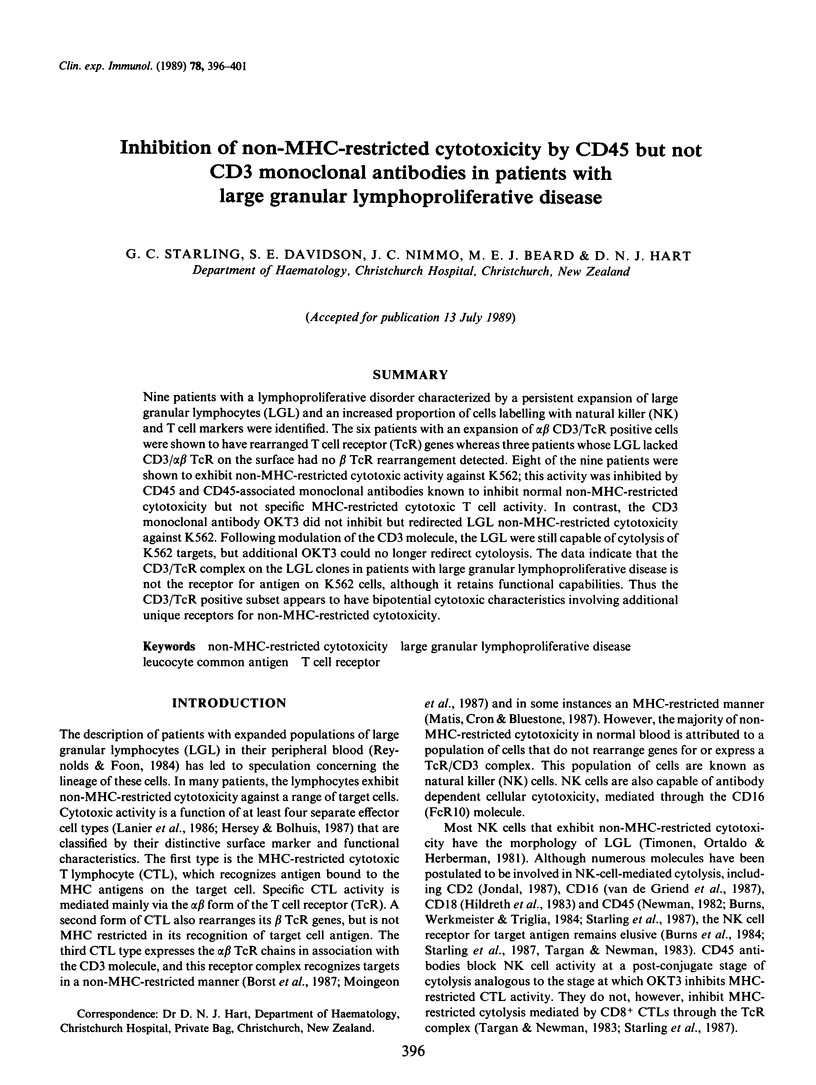
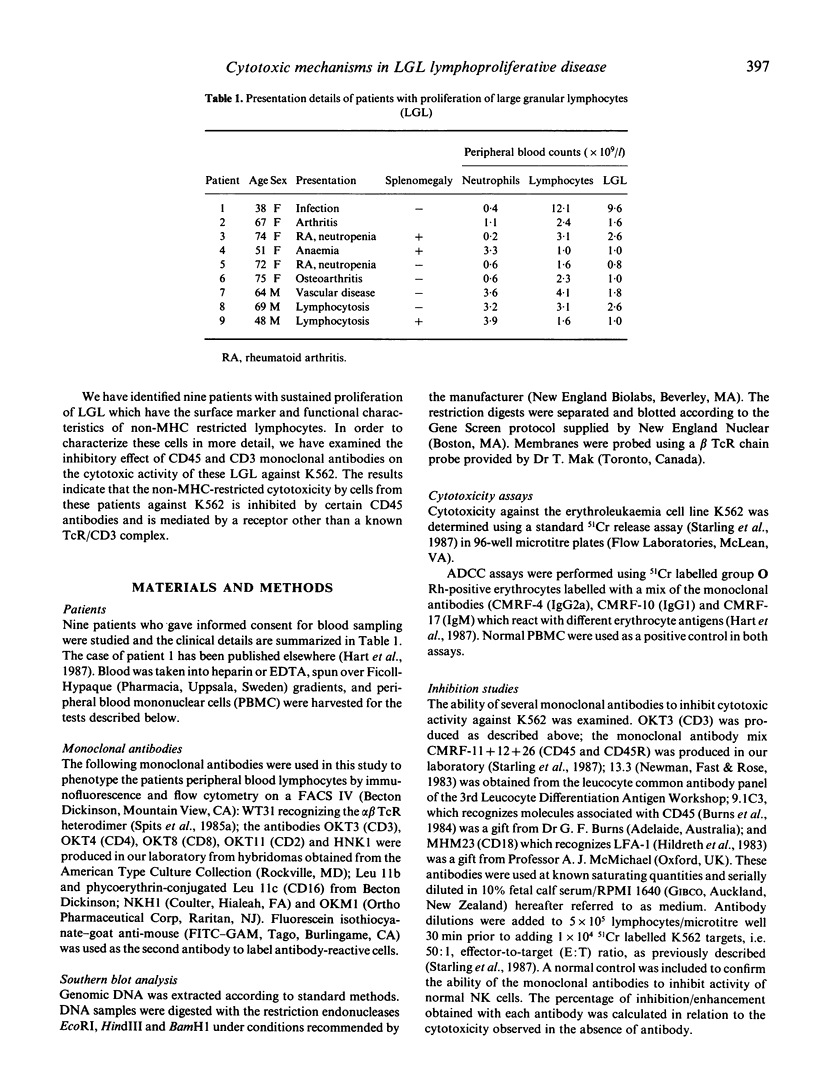
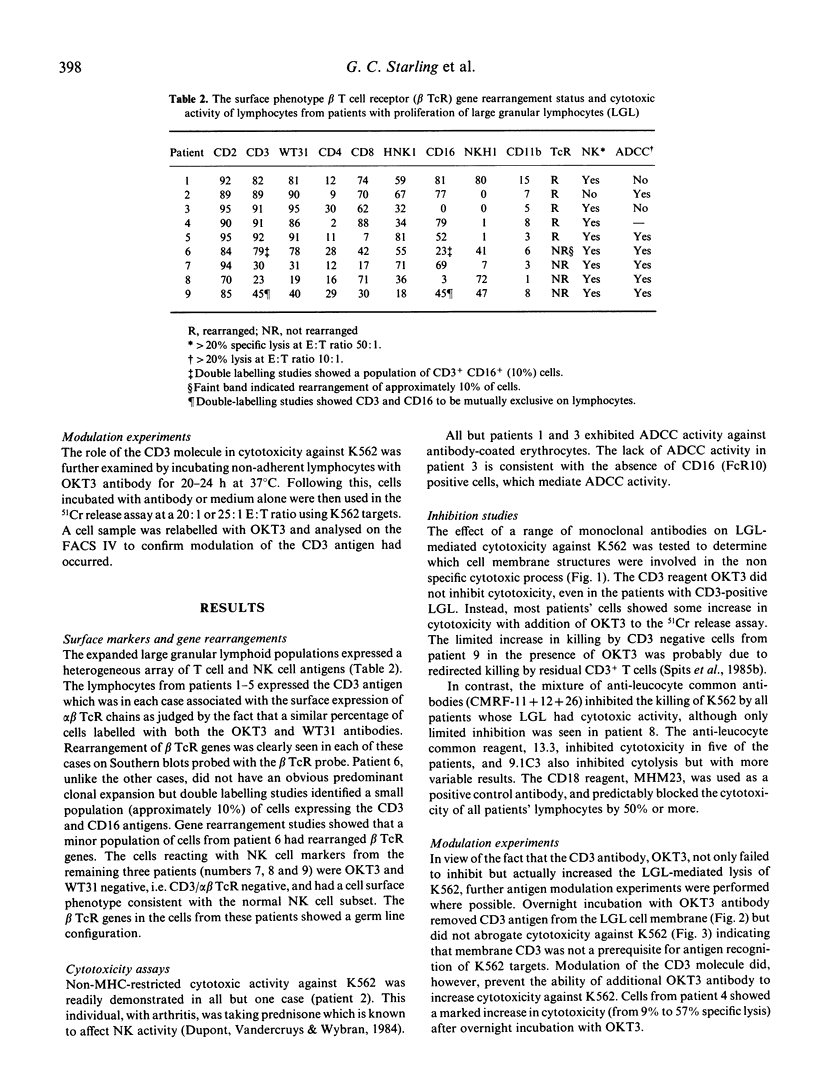
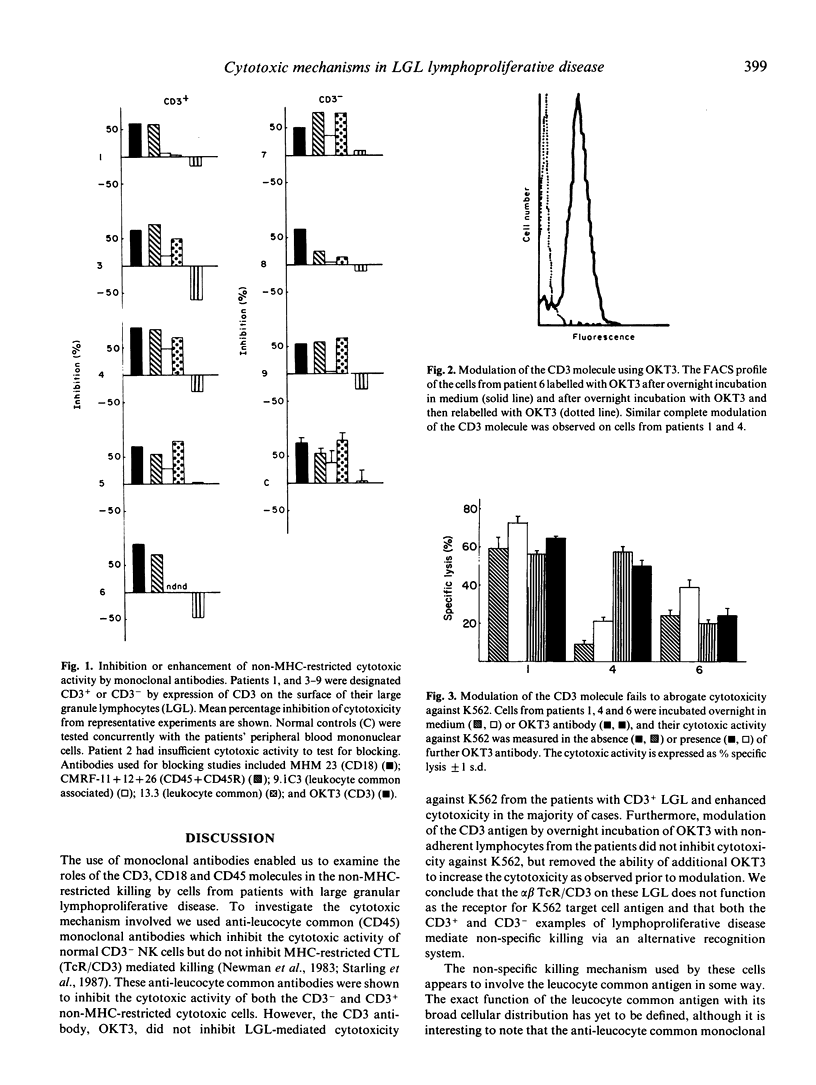
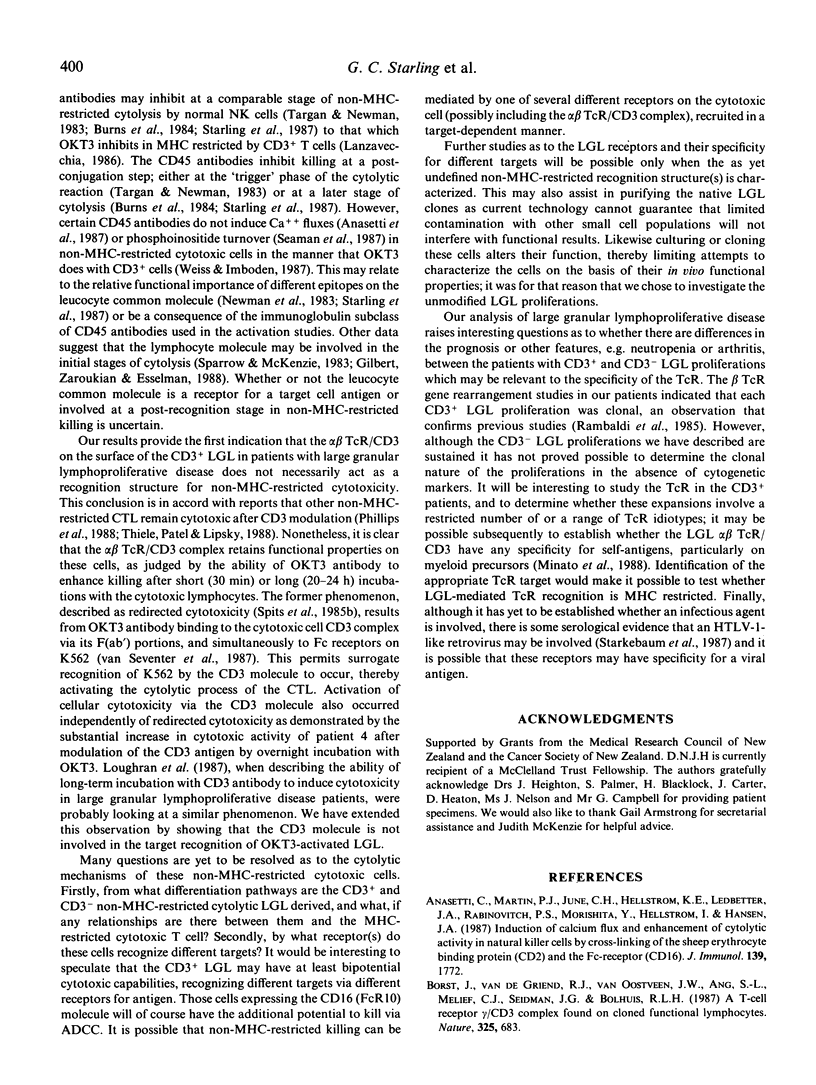

Selected References
These references are in PubMed. This may not be the complete list of references from this article.
- Anasetti C., Martin P. J., June C. H., Hellstrom K. E., Ledbetter J. A., Rabinovitch P. S., Morishita Y., Hellstrom I., Hansen J. A. Induction of calcium flux and enhancement of cytolytic activity in natural killer cells by cross-linking of the sheep erythrocyte binding protein (CD2) and the Fc-receptor (CD16). J Immunol. 1987 Sep 15;139(6):1772–1779. [PubMed] [Google Scholar]
- Borst J., van de Griend R. J., van Oostveen J. W., Ang S. L., Melief C. J., Seidman J. G., Bolhuis R. L. A T-cell receptor gamma/CD3 complex found on cloned functional lymphocytes. Nature. 1987 Feb 19;325(6106):683–688. doi: 10.1038/325683a0. [DOI] [PubMed] [Google Scholar]
- Gilbert C. W., Zaroukian M. H., Esselman W. J. Poly-N-acetyllactosamine structures on murine cell surface T200 glycoprotein participate in natural killer cell binding to YAC-1 targets. J Immunol. 1988 Apr 15;140(8):2821–2828. [PubMed] [Google Scholar]
- Hart D. N., Leahy M. F., McKenzie J. L., Furley A. J., Carter J., Beard M. E. Functional analysis of a clonal expansion of Leu 11 positive NK active lymphoid cells. Br J Haematol. 1987 Mar;65(3):277–287. doi: 10.1111/j.1365-2141.1987.tb06854.x. [DOI] [PubMed] [Google Scholar]
- Hildreth J. E., Gotch F. M., Hildreth P. D., McMichael A. J. A human lymphocyte-associated antigen involved in cell-mediated lympholysis. Eur J Immunol. 1983 Mar;13(3):202–208. doi: 10.1002/eji.1830130305. [DOI] [PubMed] [Google Scholar]
- Jondal M. The human NK cell--a short over-view and an hypothesis on NK recognition. Clin Exp Immunol. 1987 Nov;70(2):255–262. [PMC free article] [PubMed] [Google Scholar]
- Lanier L. L., Phillips J. H., Hackett J., Jr, Tutt M., Kumar V. Natural killer cells: definition of a cell type rather than a function. J Immunol. 1986 Nov 1;137(9):2735–2739. [PubMed] [Google Scholar]
- Lanzavecchia A. Is the T-cell receptor involved in T-cell killing? 1986 Feb 27-Mar 5Nature. 319(6056):778–780. doi: 10.1038/319778a0. [DOI] [PubMed] [Google Scholar]
- Loughran T. P., Jr, Draves K. E., Starkebaum G., Kidd P., Clark E. A. Induction of NK activity in large granular lymphocyte leukemia: activation with anti-CD3 monoclonal antibody and interleukin 2. Blood. 1987 Jan;69(1):72–78. [PubMed] [Google Scholar]
- Matis L. A., Cron R., Bluestone J. A. Major histocompatibility complex-linked specificity of gamma delta receptor-bearing T lymphocytes. Nature. 1987 Nov 19;330(6145):262–264. doi: 10.1038/330262a0. [DOI] [PubMed] [Google Scholar]
- Minato N., Hattori M., Sudo T., Kano S., Miura Y., Suda J., Suda T. Differentiation in vitro of T3+ large granular lymphocytes with characteristic cytotoxic activity from an isolated hematopoietic progenitor colony. J Exp Med. 1988 Mar 1;167(3):762–776. doi: 10.1084/jem.167.3.762. [DOI] [PMC free article] [PubMed] [Google Scholar]
- Moingeon P., Jitsukawa S., Faure F., Troalen F., Triebel F., Graziani M., Forestier F., Bellet D., Bohuon C., Hercend T. A gamma-chain complex forms a functional receptor on cloned human lymphocytes with natural killer-like activity. Nature. 1987 Feb 19;325(6106):723–726. doi: 10.1038/325723a0. [DOI] [PubMed] [Google Scholar]
- Newman W., Fast L. D., Rose L. M. Blockade of NK cell lysis is a property of monoclonal antibodies that bind to distinct regions of T-200. J Immunol. 1983 Oct;131(4):1742–1747. [PubMed] [Google Scholar]
- Newman W. Selective blockade of human natural killer cells by a monoclonal antibody. Proc Natl Acad Sci U S A. 1982 Jun;79(12):3858–3862. doi: 10.1073/pnas.79.12.3858. [DOI] [PMC free article] [PubMed] [Google Scholar]
- Phillips J. H., Weiss A., Gemlo B. T., Rayner A. A., Lanier L. L. Evidence that the T cell antigen receptor may not be involved in cytotoxicity mediated by gamma/delta and alpha/beta thymic cell lines. J Exp Med. 1987 Nov 1;166(5):1579–1584. doi: 10.1084/jem.166.5.1579. [DOI] [PMC free article] [PubMed] [Google Scholar]
- Rambaldi A., Pelicci P. G., Allavena P., Knowles D. M., 2nd, Rossini S., Bassan R., Barbui T., Dalla-Favera R., Mantovani A. T cell receptor beta chain gene rearrangements in lymphoproliferative disorders of large granular lymphocytes/natural killer cells. J Exp Med. 1985 Dec 1;162(6):2156–2162. doi: 10.1084/jem.162.6.2156. [DOI] [PMC free article] [PubMed] [Google Scholar]
- Reynolds C. W., Foon K. A. T gamma-lymphoproliferative disease and related disorders in humans and experimental animals: a review of the clinical, cellular, and functional characteristics. Blood. 1984 Dec;64(6):1146–1158. [PubMed] [Google Scholar]
- Seaman W. E., Eriksson E., Dobrow R., Imboden J. B. Inositol trisphosphate is generated by a rat natural killer cell tumor in response to target cells or to crosslinked monoclonal antibody OX-34: possible signaling role for the OX-34 determinant during activation by target cells. Proc Natl Acad Sci U S A. 1987 Jun;84(12):4239–4243. doi: 10.1073/pnas.84.12.4239. [DOI] [PMC free article] [PubMed] [Google Scholar]
- Sparrow R. L., McKenzie I. F. A function for human T200 in natural killer cytolysis. Transplantation. 1983 Aug;36(2):166–171. doi: 10.1097/00007890-198308000-00011. [DOI] [PubMed] [Google Scholar]
- Spits H., Borst J., Tax W., Capel P. J., Terhorst C., de Vries J. E. Characteristics of a monoclonal antibody (WT-31) that recognizes a common epitope on the human T cell receptor for antigen. J Immunol. 1985 Sep;135(3):1922–1928. [PubMed] [Google Scholar]
- Spits H., Yssel H., Leeuwenberg J., De Vries J. E. Antigen-specific cytotoxic T cell and antigen-specific proliferating T cell clones can be induced to cytolytic activity by monoclonal antibodies against T3. Eur J Immunol. 1985 Jan;15(1):88–91. doi: 10.1002/eji.1830150117. [DOI] [PubMed] [Google Scholar]
- Starkebaum G., Loughran T. P., Jr, Kalyanaraman V. S., Kadin M. E., Kidd P. G., Singer J. W., Ruscetti F. W. Serum reactivity to human T-cell leukaemia/lymphoma virus type I proteins in patients with large granular lymphocytic leukaemia. Lancet. 1987 Mar 14;1(8533):596–599. doi: 10.1016/s0140-6736(87)90236-4. [DOI] [PubMed] [Google Scholar]
- Starling G. C., Davidson S. E., McKenzie J. L., Hart D. N. Inhibition of natural killer-cell mediated cytolysis with monoclonal antibodies to restricted and non-restricted epitopes of the leucocyte common antigen. Immunology. 1987 Jul;61(3):351–356. [PMC free article] [PubMed] [Google Scholar]
- Targan S. R., Newman W. Definition of a "trigger" stage in the NK cytolytic reaction sequence by a monoclonal antibody to the glycoprotein T-200. J Immunol. 1983 Sep;131(3):1149–1153. [PubMed] [Google Scholar]
- Thiele D. L., Patel S. S., Lipsky P. E. Anti-CD3 and phorbol myristate acetate regulation of MHC unrestricted T cell cytotoxicity. Lack of a requirement for CD3/T cell receptor complex expression during tumor cell lysis. J Immunol. 1988 May 1;140(9):3253–3260. [PubMed] [Google Scholar]
- Timonen T., Ortaldo J. R., Herberman R. B. Characteristics of human large granular lymphocytes and relationship to natural killer and K cells. J Exp Med. 1981 Mar 1;153(3):569–582. doi: 10.1084/jem.153.3.569. [DOI] [PMC free article] [PubMed] [Google Scholar]
- Weiss A., Imboden J. B. Cell surface molecules and early events involved in human T lymphocyte activation. Adv Immunol. 1987;41:1–38. doi: 10.1016/s0065-2776(08)60029-2. [DOI] [PubMed] [Google Scholar]
- van Seventer G. A., Kuijpers K. C., van Lier R. A., de Groot E. R., Aarden L. A., Melief C. J. Mechanism of inhibition and induction of cytolytic activity in cytotoxic T lymphocytes by CD3 monoclonal antibodies. J Immunol. 1987 Oct 15;139(8):2545–2550. [PubMed] [Google Scholar]
- van de Griend R. J., Bolhuis R. L., Stoter G., Roozemond R. C. Regulation of cytolytic activity in CD3- and CD3+ killer cell clones by monoclonal antibodies (anti-CD16, anti-CD2, anti-CD3) depends on subclass specificity of target cell IgG-FcR. J Immunol. 1987 May 15;138(10):3137–3144. [PubMed] [Google Scholar]


